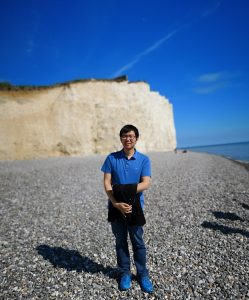
Lihua Sun, post doctoral researcher at the Turku Collegium for Science, Medicine and Technology
I sincerely wish everyone a happy new year! The 2020 was extraordinary, particularly shaded by the pandemic. Normal academic life is challenged, but it seems not to be only negative. For instance, several my colleagues expressed higher effectiveness in remote working including mentoring and writing. On my side, working remotely seems to be ideal since I can flexibly arrange my work hours while helping with family members. Nevertheless, somewhat lack of social life sounds depressing for many people, not to mention other challenges like unemployment or loss of close ones. Beyond all consequences of the pandemic, however, I would like to raise my concern for winter blues which may also greatly affect sociality and joyfulness.
We are still in the darkest wintertime, where emotionally down with less motivation for social interactions (maybe also sleeping too much, little to no energy, or eating too much) characterizes the winter blues, or known as the seasonal depression. You may be surprised that, in Finland, winter blues or its sub-syndromes affect over one third of the population. Causal factors for it include the short daylength, and the first-in-line choice for treatment is light therapy. Daylength in southern Finland ranges seasonally from 6 till 20 hours (or 7 till 23 hours when counting the morning and evening twilight). Darkness is a prominent character of the Finnish winter, since it lacks daylight plus the mostly cloudiness. While darkness often accompanies bad emotions that we may subjectively feel, my recent study highlighted one brain mechanism potentially explaining it, i.e., seasonal variation in socio-emotionally important brain neurotransmission.
I am a postdoctoral researcher at the TCSM, and I study human emotions with different types of brain imaging techniques including PET, fMRI and EEG. One of my research interests is to understand how light affects our emotions and brain physiology. In my recent brain imaging study, I analyzed a large brain database of brain PET images collected during the past 20 years during all seasons. These brain images quantify the number of opioid receptors which play crucial role in emotions and social behavior. I found that daylength on the day when the image was collected considerably predicts the number of brain mu-opioid receptors in normal humans. The widely distributed brain opioid receptors have been linked with emotions and social behaviors by many previous studies, and my recent study has been recently published in the Journal of Neuroscience (PMID: 33361461).
In brief, the brain socio-emotional circuits are underlying emotions and social interactions, and they are rich in mu-opioid receptors. My study shows that the number of this receptor in the socio-emotional circuits are tuned by daylength, following an inverted-U shape. This means either too short daylength (dark winter) or too long daylength (middle of summer) are associated with lower number of these receptors. To highlight the influential role of daylength, in my study rats were put under standard laboratory condition while daylength was the only changing factor. Daylength shaped the number of brain opioid receptors into the same seasonal pattern as in humans, plus that it also significantly influenced weight gain and stress hormone levels. Therefore, be alert for the sound effect of daylength on physiology! We live in a complex environment where effect of daylength is often confounded by many different elements, and thus we have many reasons to doubt the critical roles of daylength. Nevertheless, while we live in the darkest time of the year, effect of extremely short daylength may be so overwhelming that we easily feel blue.
Luckily, after the winter solstice daylength starts to increase. I cannot wait for the bright and joyful spring, and I wish to see more social activities when life comes to normal! However, above all messages that I am trying to deliver, keep yourself safe till the pandemic is gone. Once more, happy new year to everyone!
Lihua Sun
postdoctoral researcher at TCSMT
